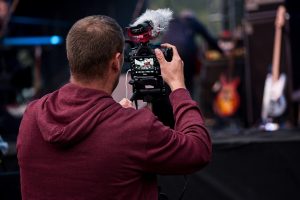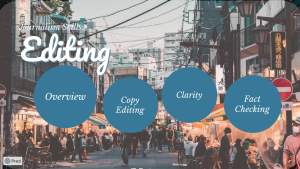42 Editing for Print
Learning Objectives
-
Practice the steps of the writing process, including planning, drafting, revision, and review.
-
Create multiple drafts of extended and short answer responses to prompts to correct and refine your writing.
Chapter & Discussion
This chapter includes a presentation that can be navigated in a classroom setting or independently. You can access the presentation via the link below.
Work through the different sections of the chapter and discuss ideas and topics as they arise. If you’re working independently, take notes instead. Notes and active discussion will be helpful in navigating this week’s assignments.
Overview
All journalists work closely with editors, who oversee what content goes into the newspaper and help journalists revise their stories so that they’re ready for print. An editor’s job includes:
- Giving journalists assignments
- Helping journalists make changes to their stories in the revision process
- Fact-checking articles
- Making sure stories comply with the newspaper’s standards for providing evidence and fair reporting
Today, we’ll practice some of these skills in the context of your writing practice.

Copy Editing
Copy editing means finding issues with written conventions. That includes:
- Spelling errors
- Issues with punctuation
- Making sure stories follow the standard academic writing format
- Finding typos (AKA typographical errors)
Every writer makes these types of mistakes. It’s important to have someone else do your copy editing because it’s easy to miss your own mistakes.
A lot of people think they can’t write because they have “bad grammar.” This is almost always not the case. These conventions are learned over time and we always get help in correcting them.
Clarity
A much more important step than copy editing is editing for clarity. This means making sure your story is well-organized and easy to read. Here are some things an editor will consider:
Does the story have a clear pattern of organization? Editors are usually looking for the inverted pyramid structure, making sure each paragraph discussed a single topic, and that each paragraph has a topic sentence.
Is the story easy to read? Here, they’re looking for clean, simple sentences, removing jargon and “official speak,” and seeing how easy it is for the audience to understand the main idea.

Fact-Checking
The last thing an editor does is fact-check the article. This has a few important steps:
- First, editors make sure that reporters provide evidence for all claims that they make.
- Then, they check to ensure that all evidence provided can be substantiated. This means backed up by credible research, data, and other sources.
- Editors also use this step to look for possible bias that the author might have (or statements that seem biased).
This all ensures readers are getting facts and fair reporting.
Assigned Reading
Here are this week’s readings. Additionally, please read for your own personal enjoyment for 1/2 hour each day. This will be called your “Reading Zone” reading and it will coincide with many upcoming activities.
Steps for Revising Your Paper (via Purdue University)
Assignment: Editorial- Comparing Two Songs (500 Words)
Imagine you are a writer for a music magazine (like Rolling Stone or Pitchfork). Pick two songs that you think have a shared goal. Here are some possible examples:
-
Two songs that talk about a breakup
-
Two upbeat dance songs
-
Two songs that discuss the same holiday
-
Two sad songs
-
Two songs that make you feel empowered
-
Two songs in the same genre
-
Two different artists who cover the same song (or a cover and the original)
Write a short article that compares these two songs. Your article should have all the pieces of a journalist’s story:
-
A headline
-
A lede (a short, simple paragraph that gives us the big idea)
-
A nut graph (a slightly longer paragraph that goes into more depth)
-
Evidence for your ideas (in this case, use examples and quotes)
This is an editorial, so we’re looking for your opinion on the following prompt: Which song did a better job of meeting their shared goal?
Assignment: Reading Zone Response (250 Words)
For Reading Zone, you must find a novel that is interesting to you and enjoyable to read. If you need help finding a Reading Zone book, please ask. Please read your Reading Zone book for a half-hour each day. On class days, there will be time in class dedicated to reading.
Create a two-paragraph response to the reading you did this week. The first paragraph should summarize what you read this week. The second paragraph should address the following prompt:
If you could pick the soundtrack for this book, what songs would you include? Pick four or five and explain your reasoning.


